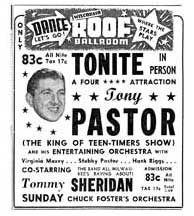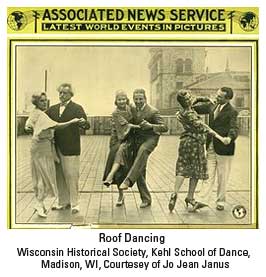
With Wisconsin claiming more ballrooms in 1940 than any state, it is understandable that the state’s largest city contained some outstanding ones. Among them were the Modernistic, the Wisconsin Roof and Devine’s Million Dollar Ballroom. They continued in the tradition of the Wells Colonial Hall, which got its start in 1884 and continued holding dances into the 1930s. On the state fair grounds, just off S. 84th Street, the Modernistic sponsored bands during the summer months. It was well patronized during its many years of operation, beginning in 1922. When it opened the season on May 22, 1937, 9,000 dancers passed through the turnstiles to do their fancy footwork to the music of Red Norvo, Frankie Master’s and Bill Carlsen’s orchestras.
Especially well attended during the fall, winter and spring months, was the Wisconsin Roof Ballroom located at 536 Wisconsin Avenue. This dance facility opened in April 1924 on the seventh floor of the then new Carpenter building. Later the Wisconsin Theatre also moved into this building and occupied the lower floors.
With many beautiful ornaments, its tasteful decorations and so many dreams coming true there, the Wisconsin Roof gained its nickname of “Aladdin’s Palace.”
Out of the 31,000 square feet available to the ballroom usage, 18,035 square feet were reserved for the dance floor. Its size made it the largest one in the state. Around the hardwood floor ran a promenade separated from it by latticework. A featured attraction of the promenade was a fancy lounge called Peacock Alley, which was beautifully decorated and furnished with large plate French mirrors, overstuffed divans, soft chairs, and a large piano.
Refreshments were available close to the dance floor served from a 130-foot bar with the walls behind it featuring paintings of ships. Near by was a balcony jutting out from the hallway by Peacock Alley. From this disguised fire escape, called “Moonlight View,” couples could gaze at the heavens, peer down at the cars scurrying around with lights tracing their paths, or engage in some romancing.

In the late 1930s and the early 1940s, between 3,000 and 10,000 people congregated in this ballroom during an evening. In one typical April evening in 1940, 7,000 patrons each paid fifty cents to dance to the music of Frank Meekins and his orchestra. During World War II, the period of its greatest popularity, the ballroom operated seven nights a week with an occasional matinee. Sailors from the Great Lakes Training Base, looking for a good time dancing and maybe romancing with the Milwaukee girls, made up a heavy portion of the patrons. To maintain order, however, the management did not permit jitterbugging, fad dancing, or cutting in.
In a few short years after World War II ended, the Wisconsin Roof suffered from a post-war slump in the ballroom business. Unable to remain profitable, the Roof shut down in 1958, with Max’s Merry Makers playing for its farewell dance hosted by Carl Dunlap, manager of the Wisconsin Roof for many years.
Excerpt from the book, Ballroom Echo’s. This book can be found in the humanities section of the Milwaukee Public Library.
